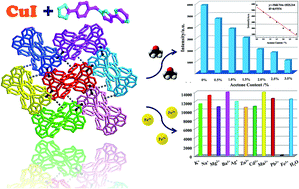Dual functional fluorescent sensor for selectively detecting acetone and Fe3+ based on {Cu2N4} substructure bridged Cu(i) coordination polymer†
Abstract
A novel red emitting coordination polymer (CP), [Cu(tpp)·H2O]2n (1) [Htpp = 1-(4-tetrazol-5′′-yl)benzyl-3-(pyraziny-l)pyrazole], has been successfully constructed using a nitrogen heterocyclic ring ligand and characterized by single crystal X-ray diffraction, infrared (IR) studies, elemental analysis and thermogravimetric analysis (TGA). 1 is a rare 3D supramolecular assembly based on a 1D polymeric chain substructure of {Cu2N4} bridged by the Htpp ligand, which is propagated to form an extended 3D structure with the help of π−π stacking and C–H⋯π hydrogen-bonded packing. Based on the phosphorescence of Cu(I)-CP, 1 is chosen as a probe for sensing different small molecules and metal ions. The luminescence properties of 1 well dispersed in different solvents have been investigated systematically, which demonstrates distinct solvent-dependent luminescence spectra with emission intensities that are significantly quenched by acetone (detection limit: 0.0842 vol%). Besides that, 1 with open Lewis basic nitrogen atoms on the chain surface was exploited for the binding and specific sensing of metal ions via Lewis base interactions, and shows high selectivity and sensitivity (Ksv = 4.6 × 104 L mol−1) for Fe3+ ions with luminescence quenching. Solid-state 1 displays excellent red lighting properties, which can be comparable with rare earth compounds. Subsequently, 1 blended poly(methyl methacrylate) PMMA film demonstrates comparable intensity with the solid state at concentrations of 1.5%, accompanied by an improvement of the luminescence lifetimes.


 Please wait while we load your content...
Please wait while we load your content...